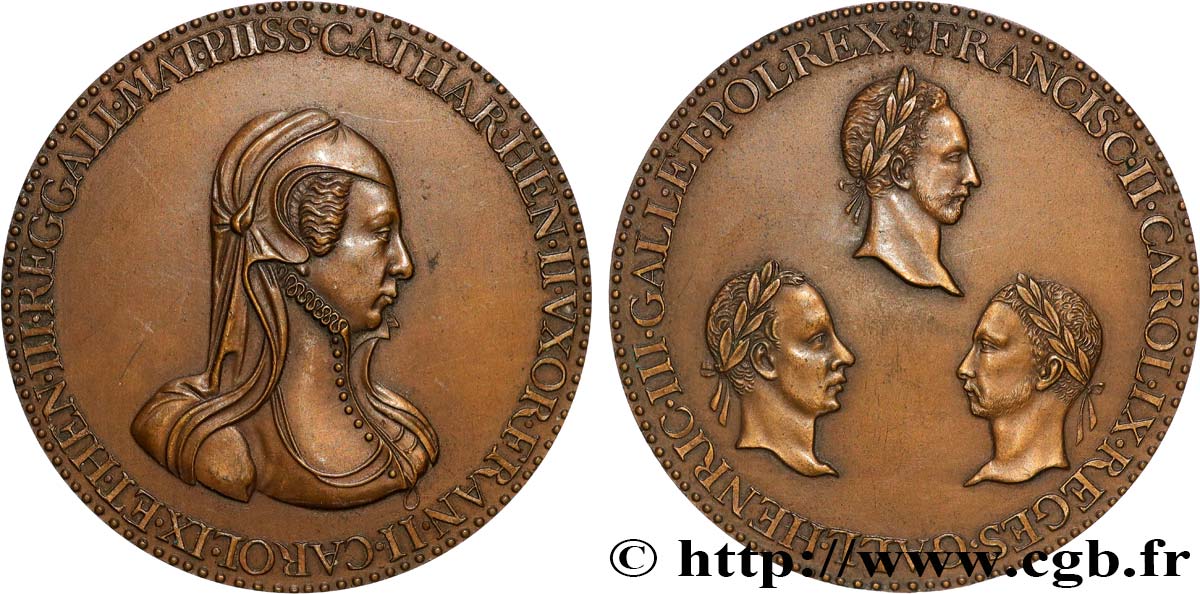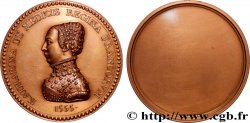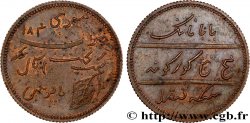正面
正面的文字 CATHAR. HEN. II. VXOR. FRAN. II CAROL. IX. ET. HEN. III. REGALI. MAT. PIISS..
正面的说明书 Buste de Catherine de Médicis, en habits de veuve, à droite.
背面
背面的文字 + FRANCISC. II. CAROL. IX. REGES. GALL. HENRIC. III. GALL. ET. POL. REX.
背面的说明书 Trois têtes laurées en 1 sur 2 de François II, Charles IX et Henri III.
评论
历史细节
CATHERINE DE' MEDICI
(1519-1589)
Catherine de Medici was born on April 13, 1519 in Florence (Italy) under the name of Caterina Maria Romola di Lorenzo de Medici.. She is the daughter of Laurent II de Medici (1492-1519), Duke of Urbino, and Madeleine de la Tour d'Auvergne (1495-1519). On the death of her parents, when she was only a few days old, she inherited the fortune of the Medici, the title of Duchess of Urbino, then that of Countess of Auvergne on the death of her aunt Anne d 'Auvergne in 1524. She owes part of her education to her uncles, Popes Leo X and Clement VII.. She left Italy in 1533, when the Pope made an alliance with the King of France, Francis I.. Her marriage to Henri, the Dauphin's brother, was celebrated in Marseille on October 28, 1533.. After her marriage, Catherine occupied little space at Court.. She is only fourteen, does not speak French well and her young husband is more interested in his confidante and mistress Diane de Poitiers.. On August 10, 1536, Catherine's destiny changed. Francis I's eldest son, Dauphin Francis, dies suddenly, making Catherine's husband heir to the throne. Catherine then became Dauphine of Viennois and titular Duchess of Brittany (1536-1547). She gradually takes her place at the Court, and gives birth in January 1544 to an heir: François, future François II of France.. On the death of François I, on March 31, 1547, Henri d'Orléans ascended the throne under the name of Henri II and Catherine became Queen of France by an official coronation at the basilica of Saint-Denis on June 10, 1549. During the fifteen years that followed, she gave birth to ten children, seven of whom survived and were educated by. . . Diane de Poitiers, Catherine's enemy, who suffers in silence from her husband's infidelities. Henry II died in 1559. His son François ascends the throne. Catherine de Medici recommends that he entrust the reins of government to his wife's family: the Guise, from the house of Lorraine and related to the royal family.. The Guise are rich and powerful, therefore influential. Catherine supports them and approves of the sidelining operated by them of the constable Anne de Montmorency, with whom she ensured the regency, and of Diane de Poitiers. The reign of François II is marked by the rise of religious violence. Until now Henry II had very severely repressed Protestantism. The death of the latter encourages Protestants to demand freedom of conscience and that of worship. Although their leader Calvin condemns the violence, a minority of reformers want to fight it out by force. Faced with the growing threat, the Guises are in favor of a policy of repression. In 1560, on the King's death, his younger brother ascended the throne under the name of Charles IX.. As he was only ten years old and still a minor, Catherine de Medici was declared "governess of France", alongside Chancellor Michel de L'Hospital.. Faced with religious unrest, she set up a policy of conciliation with the support of moderate advisers (Poissy colloquium in 1561). She thus granted the Protestants the Peace of Amboise in March 1563.. After four years of peace, religious conflict resumes. In 1567, the Prince of Condé tries to seize the king by surprise. It is the "surprise of Meaux": Charles IX and Catherine take refuge in Paris, amazed at the betrayal of the leader of the Protestants. The royal power decides to finish with the rebels and terrible wars ensue, ruining the country. Both sides come to the end of their strength in 1570. Catherine urges Protestants to accept the Peace of Saint-Germain-en-Laye, which grants them very limited freedom of worship. Nevertheless, to achieve a lasting peace between the two religious parties, Catherine plans to arrange the marriage of her daughter, Marguerite with the Protestant Bourbon Prince Henri of Navarre.. The princely wedding is scheduled for August 18, 1572. It is accepted neither by intransigent Catholics nor by the Pope. This one and the king of Spain, Philip II, vigorously condemn the policy of the queen mother. It was in this tense context that, on August 22, 1572, an attack was perpetrated against Admiral Gaspard de Coligny, leader of the Protestants, member of the Royal Council. Protestants rise up against this attack and demand revenge. The capital is on the verge of civil war, which finally breaks out with Saint-Barthélemy. The massacre begins on the night of August 24 to 25, 1572. Despite the orders of the king and his mother to stop it, it spreads the following days with the help of the people excited by some Catholic preachers to all the Parisian Protestants, then the following months in the provinces. It kills thousands of people. The Saint-Barthélemy massacre brings about a complete change in the religious question in France. Under pressure from intransigent Catholics and in the hope of reestablishing the unity of the faith more quickly, Charles IX and Catherine de Medici decided to radically change the policy of conciliation carried out with regard to Protestants.. Saint-Germain's edict is rescinded. In 1574, at the age of twenty-three, the Duke of Anjou, fourth son of Catherine, succeeded his brother under the name of Henri III.. Known to be the favorite son, and arguably the smartest, the new king intends to rule by himself. Catherine continues to exercise power, but she can no longer act without the king's consent. She died in Blois on January 5, 1589. She is buried in Saint Denis alongside her husband.. Library. indicative: CASTELNEAU, Jacques, "Catherine de Medici", Paris, Hachette, 1954; WANEGFFELEN, Thierry, "Catherine de Medici: female power", Paris, Payot, 2005; CLOULAS Ivan, "Catherine de Medici: The destiny of a queen", Paris, Tallandier, 2007; on the wars of religion see the "Que sais-je?" by Georges LIVET, "The Wars of Religion".










 对产品描述纠错
对产品描述纠错 打印
打印 分享我的选择
分享我的选择 提问
提问 Consign / sell
Consign / sell
 产品介绍
产品介绍








